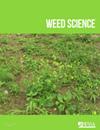野生萝卜(Raphanus raphanistrum)开花时间的适应性。第二部分:收获杂草种子控制使花期缩短 12 天
IF 2.1
2区 农林科学
Q2 AGRONOMY
引用次数: 1
摘要
收获期杂草种子控制(HWSC)是管理野生萝卜(Raphanus raphanistrum L.)的有效技术,这种杂草的种子会一直保留到收获期。然而,较早的开花时间(导致收获前种子脱落增加)是影响收割杂草种子控制效果的一个风险因素。本研究采用两种方法调查了重复水稻除草对 R. raphanistrum 花期演变的影响:一是对 SOMER 模型进行改编,将开花基因纳入其中(称为 SOMEF);二是利用相关的生命史方程对花期演变的终点进行数学计算。在使用高效除草剂的杂草管理系统中,额外使用 HWSC 可预测 R. raphanistrum 的种群灭绝。杂草数量少、灭绝速度快,这意味着初花期(DFF)的任何逐渐演变都不足以导致对 HWSC 的规避。在除草剂控制力度较弱和使用 HWSC 的替代管理系统中,模型预测初花日数最多可缩短 2-3 天。与此相反,通过对最大限度地将种子送回种子库的表型进行数学计算,预测进化的终点是提前 12 天开花,这与实地观测结果相吻合。然而,数学计算推测的基因变化并没有受到 DFF 等位基因频率变化的限制。未知的伴随基因变化可能会影响发芽日期或开花诱因。只包括开花基因的模拟建模无法预测观察到的 DFF 减少 12 天的幅度。据推测,在田间观察到的 12 天(通过数学计算预测)与这一基于田间模拟的研究中显示的适度变化之间的差异,是由于 R. raphanistrum 未计算的进化变化造成的。本文章由计算机程序翻译,如有差异,请以英文原文为准。
Adaptations in Wild Radish (Raphanus raphanistrum) flowering time. Part 2: Harvest Weed Seed Control shortens flowering by 12 days
Harvest weed seed control (HWSC) is an effective technique for managing wild radish (Raphanus raphanistrum L.), a weed which retains its seed until harvest. However, earlier flowering time (leading to increased seed shedding before harvest) is a risk to HWSC effectiveness. This study investigated the effects of repeated HWSC on the evolution of R. raphanistrum flowering dates, using two methods: an adaptation of the SOMER model that included flowering genes (called SOMEF); and a mathematical calculation of the endpoints of flowering date evolution utilising the relevant life-history equations.
In weed management systems with highly effective herbicides, the additional use of HWSC predicted R. raphanistrum population extinction. Low weed numbers and rapid extinction meant that any gradual evolution in days to first flower (DFF) was insufficient to lead to HWSC evasion. In alternative management systems with less vigorous herbicide control and using HWSC, modelling predicted a maximum 2-3 day reduction in DFF. In contrast, mathematic calculations of the phenotypes maximising seeds returned to the seedbank predicted an endpoint to evolution of 12 days earlier flowering, which matched field observations. However, genetic change postulated by the mathematical calculations was not hampered by a restriction to changing DFF allele frequencies. Unknown accompanying genetic changes could affect germination dates, or flowering triggers.
Simulation modelling that included only flowering genes failed to predict the magnitude of an observed 12-day reduction in DFF. Differences between the 12 days observed in the field (and predicted using mathematical calculations) and the modest changes demonstrated in this field-based modelling study are postulated to be due to unaccounted evolutionary changes in R. raphanistrum.
求助全文
通过发布文献求助,成功后即可免费获取论文全文。
去求助
来源期刊

Weed Science
农林科学-农艺学
CiteScore
4.60
自引率
12.00%
发文量
64
审稿时长
12-24 weeks
期刊介绍:
Weed Science publishes original research and scholarship in the form of peer-reviewed articles focused on fundamental research directly related to all aspects of weed science in agricultural systems. Topics for Weed Science include:
- the biology and ecology of weeds in agricultural, forestry, aquatic, turf, recreational, rights-of-way and other settings, genetics of weeds
- herbicide resistance, chemistry, biochemistry, physiology and molecular action of herbicides and plant growth regulators used to manage undesirable vegetation
- ecology of cropping and other agricultural systems as they relate to weed management
- biological and ecological aspects of weed control tools including biological agents, and herbicide resistant crops
- effect of weed management on soil, air and water.
 求助内容:
求助内容: 应助结果提醒方式:
应助结果提醒方式:


